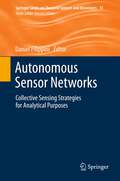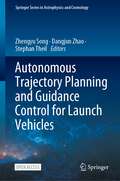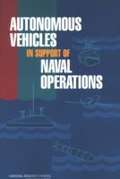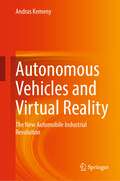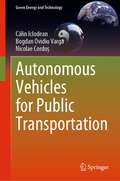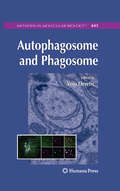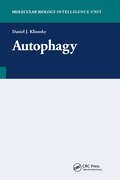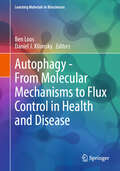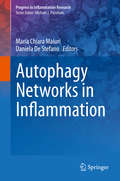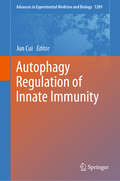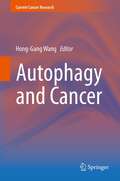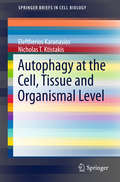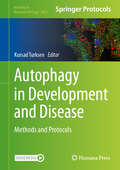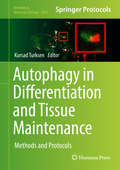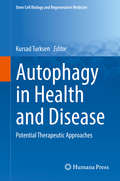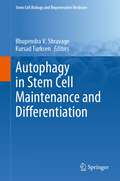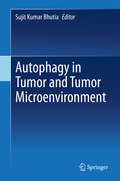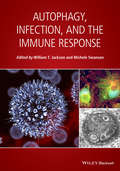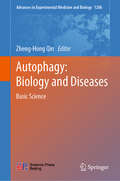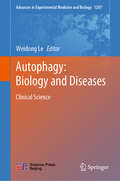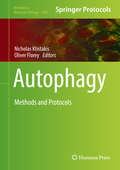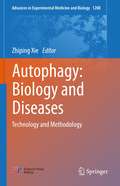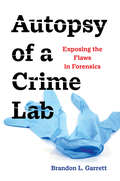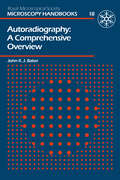- Table View
- List View
Autonomous Sensor Networks: Collective Sensing Strategies for Analytical Purposes (Springer Series on Chemical Sensors and Biosensors #13)
by Daniel FilippiniThis volume surveys recent research on autonomous sensor networks from the perspective of enabling technologies that support medical, environmental and military applications. State of the art, as well as emerging concepts in wireless sensor networks, body area networks and ambient assisted living introduce the reader to the field, while subsequent chapters deal in depth with established and related technologies, which render their implementation possible. These range from smart textiles and printed electronic devices to implanted devices and specialized packaging, including the most relevant technological features. The last four chapters are devoted to customization, implementation difficulties and outlook for these technologies in specific applications.
Autonomous Trajectory Planning and Guidance Control for Launch Vehicles (Springer Series in Astrophysics and Cosmology)
by Zhengyu Song Stephan Theil Dangjun ZhaoThis open access book highlights the autonomous and intelligent flight control of future launch vehicles for improving flight autonomy to plan ascent and descent trajectories onboard, and autonomously handle unexpected events or failures during the flight. Since the beginning of the twenty-first century, space launch activities worldwide have grown vigorously. Meanwhile, commercial launches also account for the booming trend. Unfortunately, the risk of space launches still exists and is gradually increasing in line with the rapidly rising launch activities and commercial rockets. In the history of space launches, propulsion and control systems are the two main contributors to launch failures. With the development of information technologies, the increase of the functional density of hardware products, the application of redundant or fault-tolerant solutions, and the improvement of the testability of avionics, the launch losses caused by control systems exhibit a downward trend, and the failures induced by propulsion systems become the focus of attention. Under these failures, the autonomous planning and guidance control may save the missions. This book focuses on the latest progress of relevant projects and academic studies of autonomous guidance, especially on some advanced methods which can be potentially real-time implemented in the future control system of launch vehicles. In Chapter 1, the prospect and technical challenges are summarized by reviewing the development of launch vehicles. Chapters 2 to 4 mainly focus on the flight in the ascent phase, in which the autonomous guidance is mainly reflected in the online planning. Chapters 5 and 6 mainly discuss the powered descent guidance technologies. Finally, since aerodynamic uncertainties exert a significant impact on the performance of the ascent / landing guidance control systems, the estimation of aerodynamic parameters, which are helpful to improve flight autonomy, is discussed in Chapter 7. The book serves as a valuable reference for researchers and engineers working on launch vehicles. It is also a timely source of information for graduate students interested in the subject.
Autonomous Vehicles In Support Of Naval Operations
by National Research Council of the National AcademiesThe National Academies Press (NAP)--publisher for the National Academies--publishes more than 200 books a year offering the most authoritative views, definitive information, and groundbreaking recommendations on a wide range of topics in science, engineering, and health. Our books are unique in that they are authored by the nation's leading experts in every scientific field.
Autonomous Vehicles and Virtual Reality: The New Automobile Industrial Revolution
by Andras KemenyThis book concisely describes the technologies, human perception, and cognition issues relevant to autonomous vehicles. It also gives an insight in the changes bring about our future everyday lives.Autonomous vehicles are the future of the automobile industry. Automated driving (AD), also called self-driving, raises however several multiple questions, among them those of user safety and acceptation. Comprehensive HMI system design, with windshield display technics, will be necessary to deal with driving task delegations, bringing the use of VR or augmented reality (AR) technologies. In addition, the use of VR for all the vehicle interiors will progressively be proposed for entertainment, online business activities and for modified visual motion perception to alleviate car sickness, a form of motion sickness. Indeed, car sickness is already well known for many passengers, especially when reading or operating smartphones or other display devices. It is called to increase significantly with the introduction of autonomous vehicles where all users will be for long periods in various sitting positions. These two new trends, AD and VR, are already modifying our relationship with the world and the society. All together, they will change our way of life forever. The book will be of interest to professionals in the auto industry, researchers in automotive engineering and computer science and all those interested in the future of transport.
Autonomous Vehicles for Public Transportation (Green Energy and Technology)
by Bogdan Ovidiu Varga Călin Iclodean Nicolae CordoșThis book presents an interdisciplinary approach to autonomous driving technology design and development. It discusses a methodology of simulation that allows specialists to evaluate autonomous vehicle sensors functionality and integration, energy flow, efficiency, range, and service under public transport.The design, calibration, and physical model behind each autonomous vehicle sensor and component is explained. For each specific vehicle, the powertrain is analyzed, and output results are presented through the use of specific automotive industrial software (IPG CarMaker).The book gives the reader a clear perspective of the key factors influencing the global functionality of autonomous shuttle buses with respect to both their inner components the variable exterior factors and an exhaustive legal perspective in relation of their presence on public roads.
Autophagosome and Phagosome (Methods in Molecular Biology #445)
by Vojo DereticAutophagy and phagocytosis are distinct yet partially morphologically similar processes. Understanding them is vital for the studies of cancer, aging, neurodegeneration, immunology, and infectious diseases. This book presents autophagosome and phagosome methods for novices and advanced researchers alike. Comprehensive and forward-thinking, the book offers a valuable guide to both cellular processes while inciting researchers to explore their potentially important connections.
Autophagy
by Daniel KlionskyStarting in the early 1970s, a type of programmed cell death called apoptosis began to receive attention. Over the next three decades, research in this area continued at an accelerated rate. In the early 1990s, a second type of programmed cell death, autophagy, came into focus. Autophagy has been studied in mammalian cells for many years. The recen
Autophagy - From Molecular Mechanisms to Flux Control in Health and Disease (Learning Materials in Biosciences)
by Ben Loos Daniel J. KlionskyThis textbook describes the autophagy pathway with all its key molecular mechanisms and its physiological functions from yeast to eukaryotes in a didactic and reader-friendly manner. It provides the most critical aspects that need to be understood to foster research and clinical translation in this area. Autophagy activity, mechanism and control in the context of cellular fate are central to this book, underpinned by human pathologies of priority. Further, key chapters describing major techniques required to assess autophagy activity, and highlighting starting points for the research of potential drug candidates and clinical translation, offer detailed insight into practice and application. The work represents a comprehensive study guide that allows undergraduate and postgraduate students in biology and biomedicine to rapidly engage with the most critical and recent aspects of autophagy in health and its control of disease. Written in a style that may be favourable for its use in the classroom, this book can also serve as a valuable source for teaching in the biomedical and medical sciences.
Autophagy Networks in Inflammation (Progress in Inflammation Research #0)
by Maria Chiara Maiuri Daniela De StefanoAutophagy principally serves an adaptive function to protect organisms against diverse human pathologies, including cancer and neurodegeneration. Recent developments using in vitro, ex vivo and in vivo models show the involvement of the autophagy pathway in immunity and inflammation. Moreover, direct interactions between autophagy proteins and immune signalling molecules have also been demonstrated. Defects in autophagy - similar to cancer, neurodegenerative diseases and aging - through autophagy gene mutation and/or microbial antagonism, may underlie the pathogenesis of many infectious diseases and inflammatory syndromes. In spite of the increasing awareness of the importance of autophagy in these pathophysiological conditions, this process remains underestimated and is often overlooked. As a consequence, its role in the initiation, stability, maintenance, and progression of these diseases are still poorly understood. This book reviews the recent advances regarding the functions of the autophagy pathway and autophagy proteins in immunity and inflammation, focusing on their role in self-nonself distinction, their implications in innate and adaptive immune responses and their dysregulation in the pathology of certain inflammatory and autoimmune diseases.
Autophagy Regulation of Innate Immunity (Advances in Experimental Medicine and Biology #1209)
by Jun CuiThis book discusses novel concepts and discoveries concerning the regulation of innate immunity by autophagy and autophagy-related proteins. In the past decade, there have been major advances in our understanding of the molecular mechanisms of autophagy and its physiological functions. This book highlights emerging studies on the underlying mechanisms of autophagy regulation of innate immunity, including inflammation, antiviral immunity and anti-bacterial responses and the signaling pathways that prompt or inhibit the initiation and progression of related diseases. It also offers new ideas and strategies for future drugs based on manipulating autophagy, especially selective autophagy mediated by cargo receptors. Providing a comprehensive overview of the autophagy regulation of innate immunity, it is a valuable resource for graduate students and researchers in the fields of immunology, cell biology and translational medicine.
Autophagy and Cancer (Current Cancer Research #8)
by Hong-Gang WangWith the explosion of information on autophagy in cancer, this is an opportune time to speed the efforts to translate our current knowledge about autophagy regulation into better understanding of its role in cancer. This book will cover the latest advances in this area from the basics, such as the molecular machinery for autophagy induction and regulation, up to the current areas of interest such as modulation of autophagy and drug discovery for cancer prevention and treatment. The text will include an explanation on how autophagy can function in both oncogenesis and tumor suppression and a description of its function in tumor development and tumor suppression through its roles in cell survival, cell death, cell growth as well as its influences on inflammation, immunity, DNA damage, oxidative stress, tumor microenvironment, etc. The remaining chapters will cover topics on autophagy and cancer therapy. These pages will serve as a description on how the pro-survival function of autophagy may help cancer cells resist chemotherapy and radiation treatment as well as how the pro-death functions of autophagy may enhance cell death in response to cancer therapy, and how to target autophagy for cancer prevention and therapy -- what to target and how to target it.
Autophagy and Signaling (Methods in Signal Transduction Series)
by Esther WongAutophagy and Signaling is an up-to-date overview of the many signaling pathways regulating autophagy in response to different cellular needs. Discussion includes the status and future directions of autophagy signaling research with respect to different aspects of health and disease. These include the roles of autophagy in regulating cell fate, immune response and host defense, nutrient sensing and metabolism, neural functions and homeostasis. The mechanisms and significance of cross-talk between autophagy and other cellular processes is also explored. Lastly, alterations in autophagy observed in aging and age-related pathologies are described.
Autophagy at the Cell, Tissue and Organismal Level (SpringerBriefs in Cell Biology)
by Eleftherios Karanasios Nicholas T. KtistakisThis book provides an expert summary of autophagy, a relatively new but rapidly expanding field of biomedical science with important implications in health and disease. After a historical review ranging up to the identification of autophagy genes in mammals, the authors discuss the signaling pathways that regulate autophagy, the mechanism of autophagosome formation and the physiological roles of autophagy in development, ageing, neurodegeneration, immune function and cell differentiation. A comprehensive list of useful antibodies for studying autophagy compiled as a community effort is included at the end. The book is intended for newcomers to the field, as well as more experienced researchers looking for a condensed but comprehensive introduction to the physiological function and regulation of the autophagic pathway in mammalian organisms.
Autophagy in Development and Disease: Methods and Protocols (Methods in Molecular Biology #2879)
by Kursad TurksenThis detailed book presents state-of-the-art protocols from scientists actively working in autophagy research, a crucial cellular process that regulates numerous cellular functions. The volume explores aspects of autophagy research where a better understanding of its role is vitally important, such as in the development and disease states. Written for the highly successful Methods in Molecular Biology series, chapters include introductions to their respective topics, lists of the necessary materials and reagents, step-by-step, readily reproducible laboratory protocols, and tips on troubleshooting and avoiding known pitfalls. Authoritative and practical, Autophagy in Development and Disease: Methods and Protocols serves as an ideal guide for researchers seeking to expand our knowledge of this key cell biological action.
Autophagy in Differentiation and Tissue Maintenance: Methods and Protocols (Methods in Molecular Biology #1854)
by Kursad TurksenThis detailed book compiles state-of-the-art protocols from researchers actively working in the area of autophagy, a crucial cellular process that regulates numerous cellular functions. In order to accelerate advances in the field, the volume explores aspects of autophagy research where a better understanding of its role is vitally important, such as in the maintenance of stem cell subpopulations and the regulation of differentiation. Written for the highly successful Methods in Molecular Biology series, chapters include introductions to their respective topics, lists of the necessary materials and reagents, step-by-step, readily reproducible laboratory protocols, and tips on troubleshooting and avoiding known pitfalls. Authoritative and practical, Autophagy in Differentiation and Tissue Maintenance: Methods and Protocols serves as an ideal guide for researchers seeking to expand our knowledge of this key cell biological action.
Autophagy in Health and Disease: Potential Therapeutic Approaches (Stem Cell Biology and Regenerative Medicine)
by Kursad TurksenThis timely volume explores the impact of autophagy in various human diseases, emphasizing the cell biological aspects and focusing on therapeutic approaches to these diseases. The chapters cover autophagy and its potential applications on diseases ranging from obesity, osteoarthritis, pulmonary fibrosis, and inflammation, through ALS, Parkinson's, retinal degeneration, breast cancer, alcoholic liver disease and more. The final chapters round out the book with a discussion of autophagy in drug discovery and 'bench to bedside'. Chapters are contributed by leading authorities and describe the general concepts of autophagy in health and disease, marrying cell biology and pharmacology and covering: studies derived from preclinical experiments, manufacturing considerations,and regulatory requirements pertaining to drug discovery and manufacturing and production. This volume will be useful for basic scientists as well as already practicing clinicians and advanced graduate students.
Autophagy in Stem Cell Maintenance and Differentiation (Stem Cell Biology and Regenerative Medicine #73)
by Kursad Turksen Bhupendra V. ShravageThis book covers a wide range of topics that illustrate the various functions of autophagy in stem cells and offers insights on the mechanisms by which autophagy can regulate stem-cell self-renewal and facilitate specific differentiation programs. Stem cells are unique cells present in most multicellular animals and are essential for their survival. They have two unique properties: the ability to self-renew and the ability to differentiate into one or more cell types. These characteristics of stem cells have found immense therapeutic potential in regenerative medicine. Autophagy is a crucial membrane trafficking pathway that is essential for maintaining cellular homeostasis that involves sequestration of non-functional proteins, protein aggregates and damaged organelles in double-membraned vesicles called autophagosomes, which are subsequently targeted to the lysosome for degradation. The primary aim of this book is to provide knowledge of recent developments in our understanding of the role of autophagy in stem cells, including germline stem cells.Autophagy is considered a promising target for many diseases. Significant efforts are being developed to identify specific modulators of autophagy, which will aid in designing combinatorial therapeutic strategies that will allow significant improvements in regenerative medicine.
Autophagy in tumor and tumor microenvironment
by Sujit Kumar BhutiaThis book deals with the paradoxical role of autophagy in tumor suppression and tumor promotion in cancer cells. Autophagy plays opposing, context-dependent roles in tumors; accordingly, strategies based on inhibiting or stimulating autophagy could offer as potential cancer therapies. The book elucidates the physiological role of autophagy in modulating cancer metastasis, which is the primary cause of cancer-associated mortality. Further, it reviews its role in the differentiation, development, and activation of multiple immune cells, and its potential applications in tumor immunotherapy. In addition, it examines the effect of epigenetic modifications of autophagy-associated genes in regulating tumor growth and therapeutic response and summarizes autophagy’s role in the development of resistance to a variety of anti-cancer drugs in cancer cells. In closing, it assesses autophagy as a potential therapeutic target for cancer treatment. Given its scope, the book offers a valuable asset for all oncologists and researchers who wish to understand the potential role of autophagy in tumor biology.
Autophagy, Infection, and the Immune Response
by Michele Swanson William T. JacksonAutophagy, Infection, and the Immune Response provides a unified overview of the roles of cellular autophagy during microbial infection.Introductory chapters ground the reader by laying out the autophagic pathway from a cellular perspective, and listing assays available for measuring autophagy. Subsequent chapters address virus interactions with autophagy machinery, the various roles of autophagy parasitic infection, and interactions of bacteria with the autophagic pathway. Concluding chapters explore the relationships of autophagy to systemic immune responses, including antigen presentation, ER stress, and production of IFN-gamma.Designed as a resource for those interested in initiating studies on the relationship between autophagy and infection or immunity, the book combines practical state-of the art technique descriptions with an overview of the wide variety of known interactions between pathogens and the autophagic pathway.
Autophagy: Basic Science (Advances in Experimental Medicine and Biology #1206)
by Zheng-Hong QinThis book series consists of 3 volumes covering the basic science (Volume 1), clinical science (Volume 2) and the technology and methodology (Volume 3) of autophagy. Volume 1 focuses on the biology of autophagy, including the signaling pathways, regulating processes and biological functions. Autophagy is a fundamental physiological process in eukaryotic cells. It not only regulates normal cellular homeostasis, and organ development and function, but also plays an important role in the pathogenesis of a wide range of human diseases. Thanks to the rapid development of molecular biology and omic technologies, research on autophagy has boomed in recent decades, and more and more cellular and animal models and state-of the-art technologies are being used to shed light on the complexity of signaling networks involved in the autophagic process. Further, its involvement in biological functions and the pathogenesis of various diseases has attracted increased attention around the globe. Presenting cutting-edge knowledge, this book series is a useful reference resource for researchers and clinicians who are working on or interested in autophagy.
Autophagy: Clinical Science (Advances in Experimental Medicine and Biology #1207)
by Weidong LeThis book consists of 3 volumes: Basic Science (Volume 1), Clinical Science (Volume 2) and Technology and Methodology (Volume 3). Volume 2 focuses on the clinical aspects of autophagy research, discussing the role of autophagy in neuropsychiatric disorders, the cardiovascular, immune, digestive and endocrine systems, as well as tumors, infection, the kidney, and the respiratory and hematological systems. It also addresses autophagy-related drug development. Written and edited by a team of 90 experts, and presenting the state of the art in autophagy research, this book is a valuable reference resource for researchers and clinicians alike. It can also be used as supplementary material for graduate students majoring in biology and medicine
Autophagy: Methods and Protocols (Methods in Molecular Biology #1880)
by Nicholas Ktistakis Oliver FloreyThis volume details a comprehensive and extensive set of protocols for the study of autophagy in vitro and in vivo. Chapters focus on mammals, various model organisms, and provide protocols for the study of autophagy-related processes outside of the canonical autophagy pathways. Written in the highly successful Methods in Molecular Biology series format, chapters include introductions to their respective topics, lists of the necessary materials and reagents, step-by-step, readily reproducible laboratory protocols, and tips on troubleshooting and avoiding known pitfalls. Authoritative and cutting-edge, Autophagy: Methods and Protocols aims to ensure successful results in the further study of this vital field.
Autophagy: Technology and Methodology (Advances in Experimental Medicine and Biology #1208)
by Zhiping XieThis book series consists of 3 volumes covering the basic science (Volume 1), clinical science (Volume 2) and the technology and methodology (Volume 3) of autophagy. Volume 3 focuses on the technical aspects of autophagy research. It is comprised of two parts. The first part discusses the basic process of autophagy, including its overall classification and individual stages in the life cycle of autophagosomes. The second part discusses the tools, strategies, and model systems in current autophagy research, including cell and animal models, detection and manipulation methods, as well as screening, genomic, proteomic and bioinformatic approaches. The book is written and edited by a team of active scientists. It is intended as a practical reference resource for interested researchers to get started on autophagy studies.
Autopsy of a Crime Lab: Exposing the Flaws in Forensics
by Brandon L. GarrettThis book exposes the dangerously imperfect forensic evidence that we rely on for criminal convictions."That's not my fingerprint, your honor," said the defendant, after FBI experts reported a "100-percent identification." They were wrong. It is shocking how often they are. Autopsy of a Crime Lab is the first book to catalog the sources of error and the faulty science behind a range of well-known forensic evidence, from fingerprints and firearms to forensic algorithms. In this devastating forensic takedown, noted legal expert Brandon L. Garrett poses the questions that should be asked in courtrooms every day: Where are the studies that validate the basic premises of widely accepted techniques such as fingerprinting? How can experts testify with 100 percent certainty about a fingerprint, when there is no such thing as a 100 percent match? Where is the quality control in the laboratories and at the crime scenes? Should we so readily adopt powerful new technologies like facial recognition software and rapid DNA machines? And why have judges been so reluctant to consider the weaknesses of so many long-accepted methods?Taking us into the lives of the wrongfully convicted or nearly convicted, into crime labs rocked by scandal, and onto the front lines of promising reform efforts driven by professionals and researchers alike, Autopsy of a Crime Lab illustrates the persistence and perniciousness of shaky science and its well-meaning practitioners.
Autoradiography
by John R.J. BakerThis book describes levels of autoradiography, which is the localization within a solid specimen of a radiolabel, to help the beginner or biologist choose the correct approach for particular application. It attempts to lay emphasis on certain aspects of the appraisal of autoradiographs.
